Amanda Roberts's Blog, page 10
December 31, 2017
Guest Post – 6 Best Natural Wonders to Explore in China
Due its rich culture and plethora of natural wonders, China is among the most incredible travel destinations. It boasts a wide variety of landscape and places to visit, from sandstone pinnacles, to turquoise lakes, to white sand beaches. There’s truly something here to quenches everyone’s travel craving. Consider visiting these 6 arguably best natural wonders that China has to offer.
Jiuzhaigou
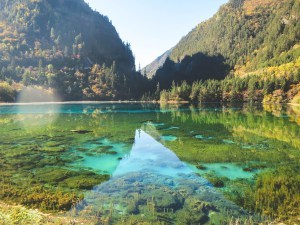 Imagine yourself sitting on the shore, gazing up in every direction at snow-capped mountains. You’re swept up by multicolored trees and bottomed by turquoise-infused waters. Take one look at this place for yourself and you’ll see why it tops the list of the best natural wonders in China. Situated in the northern-most area of the Sichuan province, Jiuzhaigou is a wonder of its own. When translated, Jiuzhaigou means “Valley of Nine Fortified Villages.” It’s no wonder that tourists and locals alike escape here from bigger cities to experience this unspoiled land. Unfortunately, the national park is closed due to the extensive damage of the earthquake in August 2017. But don’t fret, as it’s rumored to be opening back up sometime within the next year.
Imagine yourself sitting on the shore, gazing up in every direction at snow-capped mountains. You’re swept up by multicolored trees and bottomed by turquoise-infused waters. Take one look at this place for yourself and you’ll see why it tops the list of the best natural wonders in China. Situated in the northern-most area of the Sichuan province, Jiuzhaigou is a wonder of its own. When translated, Jiuzhaigou means “Valley of Nine Fortified Villages.” It’s no wonder that tourists and locals alike escape here from bigger cities to experience this unspoiled land. Unfortunately, the national park is closed due to the extensive damage of the earthquake in August 2017. But don’t fret, as it’s rumored to be opening back up sometime within the next year.
Li River, Guangxi
 Whether you fancy a rustic bamboo raft or a luxury cruise ship, the Li River is an absolute must see for any wanderer traveling to China. Towering above the blue river, limestone mountains can be seen for miles and miles as they fade from a green jungle tint to a faded blue haze. Keep your camera handy as there are many unique natural land curvatures that you certainly don’t want to miss.
Whether you fancy a rustic bamboo raft or a luxury cruise ship, the Li River is an absolute must see for any wanderer traveling to China. Towering above the blue river, limestone mountains can be seen for miles and miles as they fade from a green jungle tint to a faded blue haze. Keep your camera handy as there are many unique natural land curvatures that you certainly don’t want to miss.
Reed Flute Cave
 Calling all musicians and artists: this cave is more than just a natural wonder. Also known as “the Palace of Natural Arts,” the Reed Flute cave is a 787-foot-long, water-eroded cave that grows an abundant supply of reed used to make flutes. Once functioning as a bomb shelter, this cave was rediscovered by fleeing Japanese troops in the 1940s. Once inside, you can see the faint yet distinct petrified remains of jellyfish and snails interspersed around the cave’s floor. Although a natural work of art, artificial mood lighting has been placed throughout the cave to provide an even more immersive experience. Once finished with your tour, make sure to bring some spare cash to purchase a reed flute of your own!
Calling all musicians and artists: this cave is more than just a natural wonder. Also known as “the Palace of Natural Arts,” the Reed Flute cave is a 787-foot-long, water-eroded cave that grows an abundant supply of reed used to make flutes. Once functioning as a bomb shelter, this cave was rediscovered by fleeing Japanese troops in the 1940s. Once inside, you can see the faint yet distinct petrified remains of jellyfish and snails interspersed around the cave’s floor. Although a natural work of art, artificial mood lighting has been placed throughout the cave to provide an even more immersive experience. Once finished with your tour, make sure to bring some spare cash to purchase a reed flute of your own!
Yellow Mountains
 Dating back to 747 AD, the Yellow Mountains weren’t named for their color, but specifically because of the Yellow Emperor, Huang Di. With quite the variety of features, the Yellow Mountains are one of the most famous and popular mountainous regions of China. Its most well-known features are its hard-wood yet character-ridden pine trees, interestingly shaped rocks, “seas of cloud,” and hot springs. Located just 300 miles southwest of Shanghai, it’s just far enough away from the hustle of the city, yet close enough for an easy commute. With numerous attractions, hotels, and restaurants, plan to spend a little extra time to fully experience the rich culture and beauty of the Yellow Mountains.
Dating back to 747 AD, the Yellow Mountains weren’t named for their color, but specifically because of the Yellow Emperor, Huang Di. With quite the variety of features, the Yellow Mountains are one of the most famous and popular mountainous regions of China. Its most well-known features are its hard-wood yet character-ridden pine trees, interestingly shaped rocks, “seas of cloud,” and hot springs. Located just 300 miles southwest of Shanghai, it’s just far enough away from the hustle of the city, yet close enough for an easy commute. With numerous attractions, hotels, and restaurants, plan to spend a little extra time to fully experience the rich culture and beauty of the Yellow Mountains.
Stone Forest
 Lying in the depths of China’s Yunnan Province sits the iconic Shilin. Carved by earthquakes and the elements, one could easily get lost among its giant pillars of limestone. With natural separations of caves, waterfalls, ponds, an underground river, and an even an island lake, make sure this place is on your itinerary. One famous legend tells of a beautiful maiden named Ashima who was kidnapped by the boy of an evil landlord. Against her will, she was put but in bondage and forced to marry him. Later, her true love, Ahei, came to her rescue with bows and arrows. He was too late as she drowned in a flood on the way home and transformed into what’s commonly known today as the Ashima rock. To the local Sani people, she’s seen as their protector. If possible, visit on June 24th where the Sanis hold a torch festival at Shilin to honor their many traditions.
Lying in the depths of China’s Yunnan Province sits the iconic Shilin. Carved by earthquakes and the elements, one could easily get lost among its giant pillars of limestone. With natural separations of caves, waterfalls, ponds, an underground river, and an even an island lake, make sure this place is on your itinerary. One famous legend tells of a beautiful maiden named Ashima who was kidnapped by the boy of an evil landlord. Against her will, she was put but in bondage and forced to marry him. Later, her true love, Ahei, came to her rescue with bows and arrows. He was too late as she drowned in a flood on the way home and transformed into what’s commonly known today as the Ashima rock. To the local Sani people, she’s seen as their protector. If possible, visit on June 24th where the Sanis hold a torch festival at Shilin to honor their many traditions.
Longsheng Rice Terraces, Guangxi
 Just when you thought China could not get any more diverse in its natural beauty, rice paddies (or rice terraces) can’t be left out. Although manmade, this perfectly chiseled landscape is unmatched in its beauty and craftsmanship. Over 700 years old, rice is still farmed on these lands by the local Yao and Zhuang villagers. Resembling almost perfectly carved steps, the ancient topography makes use of scarce resources such as flat land and limited water supply. If you happen to visit right after the rain, the terraces that the grandeur of this natural wonder up a notch. It’s no wonder this place is among the top stops for professional photographers and artists alike. And make sure to greet the extremely friendly and hospitable locals with “Nín hǎo” (hello) along the way!
Just when you thought China could not get any more diverse in its natural beauty, rice paddies (or rice terraces) can’t be left out. Although manmade, this perfectly chiseled landscape is unmatched in its beauty and craftsmanship. Over 700 years old, rice is still farmed on these lands by the local Yao and Zhuang villagers. Resembling almost perfectly carved steps, the ancient topography makes use of scarce resources such as flat land and limited water supply. If you happen to visit right after the rain, the terraces that the grandeur of this natural wonder up a notch. It’s no wonder this place is among the top stops for professional photographers and artists alike. And make sure to greet the extremely friendly and hospitable locals with “Nín hǎo” (hello) along the way!
Boasting the world’s greatest number and variety of world-class natural wonders, it’s nearly impossible to not fall in love with China. Whether you’re up for an adventure in the desert, mountains, beaches, forests, or even just interested in seeing incredibly unique sites, China’s natural wonders are bound to have something special for you.
Micah Trostle is an 18-year-old photographer, videographer, and travel writer for trekbible. Although he was born in the USA, his home is Papua New Guinea, where he enjoys adventure sports, camping, and loving on people! He is passionate about Papua New Guinea and hopes to move back in the near future to impact business development and help to expand communities.
The post Guest Post – 6 Best Natural Wonders to Explore in China appeared first on Two Americans in China.
December 22, 2017
One Year of Baby Daze
Last week was the one year anniversary of the day we met our little girl. It has been an amazing year. Our adoption journey was so long, and there were times I doubted I’d ever become a mother. But now, I can’t hardly imagine a time when our little girl wasn’t with us. She has come so far, and she makes progress that astounds me every day. Bust just look at how much she has changed! She seems to have gone from a baby to a little girl overnight.
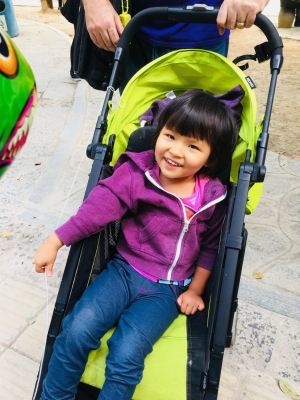
She is a smart, happy little girl, and we are so in love with her. Of course, there have been challenges along the way, but I think that is true no matter how your child comes into your life. She is perfect to me, and just what I always wanted. She is my gift that keeps on giving. Sorry if this post is a bit sappy, I started crying just looking at the pictures to put in this post even though she is sitting in the other room, but my heart is full to bursting every time I think about her.
If you feel your family is ready for a child, please consider adoption. I am more than happy to talk to you about it. You can always message me here through the blog or my Facebook page.
Here are a couple more cute baby pictures because she is simply adorable!
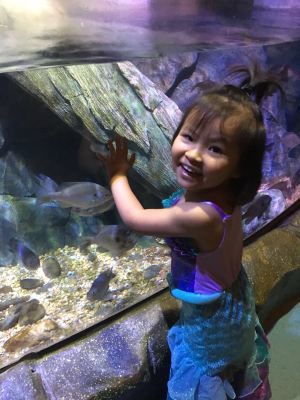

The post One Year of Baby Daze appeared first on Two Americans in China.
December 14, 2017
Great Tips For Traveling While Vegetarian
Traveling if you’re on a vegetarian diet isn’t easy, but it’s not impossible either. Thankfully, you can now easily go online and find more information about the new places that you want to visit. You can plan ahead and see what kinds of dishes are available and applicable to your vegetarian diet.
Before you start packing for your next trip, here are a few tips to help you enjoy your travel without ruining your eating habits.
Know the culture of the country you are planning to visit. Most Asian countries serve a wide variety of healthy foods but the ingredients may be different from what you are used to. Understand how they usually cook their food and check if they can serve meals according to your vegetarian diet.
Understand their menu. When you go to a restaurant (especially in Asia), it’s likely that you’ll get confused with the name of their dishes. Search for their common dishes so you have a better idea of what dishes to order once you get there.
Check the ingredients of the country’s vegan and vegetarian meals. It can be hard to communicate in English when you are in another country. They may not understand your vegetarian diet and as a result, you will end up with some foods that you are unable to eat.
 https://pixabay.com/en/almonds-nuts-r...
https://pixabay.com/en/almonds-nuts-r...Check the local restaurants. Search for restaurants that serve vegetarian meals. Most vegetarians say that it is easy to find vegan breakfasts and lunches in Japan, as well as other parts of Asia. As a quick tip, know if Buddhism is being practiced in the country you’re traveling to. China, India, Singapore, Vietnam, Thailand, and other Asian countries are home to some of the world’s biggest Buddhist groups, so you’re sure to find good vegetarian meals there.
Pack your snacks and bring them wherever you go. Packing your own food is the best way to stick to your vegetarian diet while traveling. Walking around a new city can be exhilarating, but it can tire you out as well. Thus, it’s safe to keep your stomach full while visiting different spots to avoid giving in to the temptation of eating whatever you find available while on the road.
Check out the pictures on menus. One of the safest ways to eat in China (as well as in Hong Kong and Macau) is to look for a menu that has pictures. If you don’t understand the names of the dishes, pictures can help you determine what food to order. https://pixabay.com/en/males-children...
https://pixabay.com/en/males-children...
Learn some foreign phrases in the country you are visiting. Know the words that will help you order the food of your choice. You can’t expect everyone to understand your vegan diet, especially when you can’t explain what kind of foods are you looking for. By learning a few phrases from another language, you can easily place an order if you know the names of the foods that you like.
Ask your hotel or hostel for recommendations. They can provide you a wealth of information regarding their local cuisine.
If you have the budget, look for hotels or hostels that feature a kitchen. That way, you can cook your own food and store your healthy snacks if you don’t find any local dishes to your liking.
Dine with local vegetarians. You can check out vegetarian forums online and meet with them. They can tell you about some great spots that serve healthy meals.
Bring some hot sauce and spices with you. Sauce and spices can enhance the taste, which can help a lot when the local dish is too bland for your taste buds.
Explore the local markets. They can offer more variety of healthy foods at cheaper prices. You’d be surprised at the local fruits, vegetables, bread, and other vegetarian meals you’ll discover.
If you’ll be traveling by air, make sure to indicate that you prefer a vegetarian or vegan meal when booking your flight. You don’t want to be stuck with a non-vegetarian meal and find yourself starving on your way to your destination.
Claire works in marketing team at Brillopak, a premium quality, small footprint robotic packing, food packing machine and palletizing machine manufactures in the United Kingdom. In a former life, Claire worked as a content specialist and she loves writing, reading & cooking.
The post Great Tips For Traveling While Vegetarian appeared first on Two Americans in China.
December 9, 2017
Christmas With Chinese Characteristics

 Last year at this time, we were only focused on bringing our little girl home, and we’ve never been big Christmas people, so we had just a pitiful little tree and bought some gifts for our little girl at the last minute. So this year I decided to put a lot more effort into the holiday to start making traditions for our growing family.
Last year at this time, we were only focused on bringing our little girl home, and we’ve never been big Christmas people, so we had just a pitiful little tree and bought some gifts for our little girl at the last minute. So this year I decided to put a lot more effort into the holiday to start making traditions for our growing family.
I’m calling our theme “Christmas with Chinese Characteristics.” For our tree, the main color is red and I included my Mulan and Mushu inspired ornaments that I got at Disney World when we were there this summer.
I have also hidden hongbao in the tree with different amounts of money in them. On Christmas day everyone will pick a hongbao and get either a little bit of money or a lot of bit of money.
I also used hongbao as tags on the gifts. I taped the flap to the boxes so you just flip them up to see who gets the box. I’m not the most crafty person, but I really like the hongbao gift tags. Of course, I buy my hongbao here in China, but You can find lots of hongbao on Amazon.

The pièce de résistance of the tree, though, is our Monkey King tree topper. He is actually a puppet that I got at Silver Dollar City many years ago. He is the protector of the tree, warding away destructive cats and kids.

After Christmas, I plan to keep the tree up and convert it into a Chinese New Year tree. I am going to replace a lot of the ornaments with little lanterns and hopefully find some small oranges I can attach to the tree. I’ll have to add a lot more hongbao as well.
So what do you think? Do you try to incorporate Chinese elements into your holiday celebrations? Let me what you do in the comments!
The post Christmas With Chinese Characteristics appeared first on Two Americans in China.
November 26, 2017
Hongcun: China’s Link from the Past – Guest Post by Judith Ann Abayari
Do you want to see what China is like a millennium ago? Hongcun, found in the Anhui province is a 900-year old village in China. Being there is like traveling through time and seeing a part of that era preserved so beautifully. Here is a travel guide for all the people who are interested in going to Anhui and see this magnificent ancient place.
Where is Hongcun?
Hongcun, literally Hong Village in Mandarin, is a part of the eastern Anhui province in China. Anhui is more than 400 km from Shanghai. So that will take about four hours and 30 minutes of driving. If you are around Tunxi, you can get there with a bus for around 20 minutes of travel. If you are coming from Tankou, then minibuses will take you there in 35 minutes.
Best time to go…
If you are coming in the late quarter of the year, the best time would be around early of November. It is autumn at that time and everything is vivid and picturesque from any vantage point.
March and April is the ideal time to see the “Sea of Flowers” as it is at that time the valleys are in full blossom. Colors of life and nature would inspire the hidden artist in everyone visiting Hongcun.
A short history
Hongcun was established during the Song Dynasty around the year 1100. It flourished through the Ming and Qing dynasties as it became the center of trade at that period.
The village was originally the ancient home of the Wang clan. And through the years, Hongcun experienced numerous changes, while preserving most of its infrastructure and culture. Additionally, they preserved most of its customs, cuisine, and regional arts. That is why stepping into the village will feel like being transported to an ancient era where technology has less influence than anyone could hope for.
Attractions
Aside from the natural sceneries such as the sea of flowers and autumn beauties, the Hongcun village pride itself from having an authentic architectural art. You will be able to see the Ming and Qing dynasties’ influences in the buildings around you.
The overall layout of the village resembles the shape of an ox. The villagers have masterfully used the canals to divert water to their courtyards creating a crisscrossed network of artful water structures. The houses will seem like paintings from afar, with little gardens around them. There is also the famous Moon Pond that you can enjoy for blissful scenery.
Hongcun may be a tourist attraction but it does not feel like one. Stalls and other tacky souvenir booths are not placed all over the village so avoiding them will be easy. That means more time for everyone to look around in its full glory. Just do not forget your camera when you go there.
It is said that the village was designed with good feng shui in mind, hence the shape of the ox. Since drones are popular nowadays, looking at the village from top view will be much easier, and will let you take a breathtaking shot.
There is much to Hongcun that words cannot describe. So it is highly advised that you get there personally and see everything for yourself. Aside from Hongcun, there are nearby tourists spots as well if ancient beauty is what you crave for. There is the Xidi, the Tachuan village, and the epic Mount Huangshan that is best for hikers alike.
The post Hongcun: China’s Link from the Past – Guest Post by Judith Ann Abayari appeared first on Two Americans in China.
November 18, 2017
Who Writes History – Conversations With Jung Chang
 As exciting as it was to meet Amy Tan, I was actually more excited to meet Jung Chang at the Hong Kong Literary Festival. I am obsessed with her book Empress Dowager Cixi: The Concubine Who Launched Modern China. I have been fascinated by Empress Cixi for years, and it was while I was researching for Threads of Silk, that her book was released. Empress Dowager Cixi became my research bible when it came to Cixi. I read many other books about her, including several contemporary accounts, but Jung Chang’s approach, bringing so many sources together in one place, was a godsend. I have read the book several times front to back and then have gone back and read and research certain chapters and passages more times than I can count. I was so happy that she was kind enough to sign my well-loved copy of Empress Dowager Cixi, but she also accepted a copy of Threads of Silk, which really made my heart soar.
As exciting as it was to meet Amy Tan, I was actually more excited to meet Jung Chang at the Hong Kong Literary Festival. I am obsessed with her book Empress Dowager Cixi: The Concubine Who Launched Modern China. I have been fascinated by Empress Cixi for years, and it was while I was researching for Threads of Silk, that her book was released. Empress Dowager Cixi became my research bible when it came to Cixi. I read many other books about her, including several contemporary accounts, but Jung Chang’s approach, bringing so many sources together in one place, was a godsend. I have read the book several times front to back and then have gone back and read and research certain chapters and passages more times than I can count. I was so happy that she was kind enough to sign my well-loved copy of Empress Dowager Cixi, but she also accepted a copy of Threads of Silk, which really made my heart soar.
I have written and spoken many times about how wonderful her book is, but I am often met with skepticism. Cixi has a reputation, in the East and the West, of being a controlling, manipulative, traditionalist who held China back and is blamed for many of China’s problems during the 19th century. Yet in Empress Dowager Cixi, Jung Chang paints a much more complicated picture of Cixi, one that gives her far more credit for China’s sudden leap into the modern age during her reign.

She credited Cixi with everything modern that China has today, from the electricity to the railroad, to the iron used to build the buildings. She also talked about Cixi was, in many ways, a feminist. She set up China’s first schools for girls and outlawed footbinding (even though the practice stayed in vogue until the communist era). She was not perfect, but Cixi would be the first person to admit to that. Her role in the Boxer Rebellion is something that she cannot escape, but she never tried to. She apologized, formally, for her role in the rebellion, and did her best to learn from her mistakes. Her reign post-Boxer Rebellion were some of China’s most prosperous and peaceful years. In fact, the foreign powers welcomed her back to the Forbidden City after the Boxer Rebellion. Even though the Boxer Rebellion was specifically a rebellion against foreign influence, the Western powers wanted Cixi back on the throne.
Many have called Jung Chang’s book about Cixi “revisionist,” as if that is a bad thing, so I asked her, “What do you say to critics who call into doubt the version of Cixi that you present in the book?”
“What wrong with revisionism?” she asked. Indeed, if the history we have been fed is wrong, why should it just be accepted because it is old? Why shouldn’t it be revised? She went on to say that, “People who doubt what I have written here should keep an open mind.”
It was truly a joy to meet Jung Chang and get to hear what she personally thought about the empress and her book. She also hinted that her next book will be about China’s first elections, which were also arranged by Empress Cixi before her death, so I can’t wait to read that.
Have you read any of Jung Chang’s books? Let me know what you think of them in the comments.
The post Who Writes History – Conversations With Jung Chang appeared first on Two Americans in China.
November 16, 2017
Where The Past Begins – A Conversation With Amy Tan
 I was so excited for the chance to meet Amy Tan last week at the Hong Kong Literary Festival! It really was a dream come true. She has such an elegant presence. As soon as she walks into a room, you know she is someone worth listening to. The moderator at the gala dinner said, “I think we can all divide our lives into ‘before’ and ‘after’ we read The Joy Luck Club,” and I think she was right. The Joy Luck Club was a turning point in literature, not just a great book. It showed publishers that stories about women and Asians were not only good stories, but profitable because readers were voracious for her book. Many books about Chinese-Americans and Chinese people around the world probably would not exist if The Joy Luck Club had not paved the path for them.
I was so excited for the chance to meet Amy Tan last week at the Hong Kong Literary Festival! It really was a dream come true. She has such an elegant presence. As soon as she walks into a room, you know she is someone worth listening to. The moderator at the gala dinner said, “I think we can all divide our lives into ‘before’ and ‘after’ we read The Joy Luck Club,” and I think she was right. The Joy Luck Club was a turning point in literature, not just a great book. It showed publishers that stories about women and Asians were not only good stories, but profitable because readers were voracious for her book. Many books about Chinese-Americans and Chinese people around the world probably would not exist if The Joy Luck Club had not paved the path for them.
 Amy was at the festival to talk about her new book Where the Past Begins: A Writer’s Memoir. She talked quite a bit about how her book came to be, how it originally started as a series of emails between her and her editor, and the rigorous writing schedule she committed herself to in order the finish the book. She talked quite a bit about the craft of writing and how it compares and contrasts to drawing, something else she enjoys and is quite good at, but is not the true creative outlet that works for her.
Amy was at the festival to talk about her new book Where the Past Begins: A Writer’s Memoir. She talked quite a bit about how her book came to be, how it originally started as a series of emails between her and her editor, and the rigorous writing schedule she committed herself to in order the finish the book. She talked quite a bit about the craft of writing and how it compares and contrasts to drawing, something else she enjoys and is quite good at, but is not the true creative outlet that works for her.
She gave a really good writing tip that I have been using all week. She said that she plays movie soundtracks in the background while she writes. She said classical music also works well (anything without words since you need to writing your own words), but soundtracks are especially useful because they are designed to set the mood. She said that when she goes to her writing space and turns on the music, she is right back to where she left off and it is much easier to get started and keep going. I’ve been doing that myself this week because I had a really grueling writing schedule to catch up on since I took a week off for the festival, and it really works!
I haven’t finished reading Where the Past Begins yet, so I can’t write a complete review for it, but I do have to say that so far I enjoyed her The Opposite of Fate: Memories of a Writing Life better. Where the Past Begins is more like a series of essays while The Opposite of Fate follows a more traditional memoir style.
 For me personally, the highlight of meeting Amy Tan was when she kindly accepted a copy of Threads of Silk that I gave her and agreed to take a picture with it! I in no way think that Threads of Silk is in the same league as anything Amy Tan has written, but she also revealed that she never throws anything away, so I like the idea that it will at least be sitting in her library forever.
For me personally, the highlight of meeting Amy Tan was when she kindly accepted a copy of Threads of Silk that I gave her and agreed to take a picture with it! I in no way think that Threads of Silk is in the same league as anything Amy Tan has written, but she also revealed that she never throws anything away, so I like the idea that it will at least be sitting in her library forever.
Have you ever met a writer you admire? Tell me about it in the comments!
The post Where The Past Begins – A Conversation With Amy Tan appeared first on Two Americans in China.
November 9, 2017
How To Travel China Without Speaking Chinese – Guest Post by Cara Crawford
Let’s face it, China is a confusing place. The culture alone is so jarringly different from virtually anywhere else in the world it’s hard to even know where to start. Between the noise, the pushing, the use of umbrellas on a sunny day, all the weird foods that always happen to be “good for body” and a million other cultural nuances I could fill a list a mile long with, my head’s already spinning…and we’ve haven’t even gotten to the language yet!
But for real, are they kidding me with all those symbols? I mean, the cultural differences are strange, although entertaining in a way, but now you expect us to try and navigate in a country where we not only can’t understand or speak to other people, but we can’t read the stuff either?!
Trust me, I feel ya. China can be a really overwhelming place your first time here. I’ve been there. And with so many barriers it’s no wonder many travelers steer clear of the place in favor of easier destinations.
But just when I started to think that clearly, the only people traveling in China were expats and tour goers, I came across the backpackers. These elusive unicorns have somehow used their unicorn magic to transport themselves to some of the most remote and difficult places to travel in all of China. I’m talking some serious back-country, like, 10-hour bus ride to the middle of nowhere type places. I studied Mandarin Chinese for a year and a half before I dared attempt to travel to some of these places, so how did they do it?
As I found out, quite easily really! Now for the good news, China is nothing to be afraid of, and the language is certainly no reason for not coming to visit some of the many out-of-this-world-amazing destinations this country has to offer. If they can do it, you can too!
Stay in International Hotels/Hostels
 Cycling through Tibet on a trip through Yunnan and Sichuan Provinces.
Cycling through Tibet on a trip through Yunnan and Sichuan Provinces.This one has a bit of a two-part explanation.
First, not all hotels in China will accept foreigners. We’re a lot of work, you see, with the whole reading a foreign passport dealio that is a staff requirement when checking in. If the hotel doesn’t have any English speaking staff or anyone willing to deal with foreigners, they’ll just tell you to go away. No bed for you!
Now, if you can speak Chinese you can debate this, and possibly win as the law on this is extremely outdated and pretty sporadically enforced nowadays, but without any language skills, forget it, best to just avoid this situation in the first place. Plus, to be honest, most of the hotels that don’t accept foreigners you wouldn’t want to stay in any way.
Second, any hotel or hostel that markets themselves as “international” will have at least one English speaking staff member to assist you. Hallelujah!
How do you make sure your hotel accepts foreigners?
Well if it straight up says “international hotel” or “international hostel” as part of their name then that’s a pretty big giveaway. But, if not, almost all the properties listed on foreign booking sites like Agoda or Booking.com will accept foreigners unless they say otherwise on the listing. China has their own booking sites that the locals use when booking domestic hotels, so if the hotel doesn’t want to accept foreigners they just won’t list their property on any non-Chinese site.
Save the Chinese name of your hotel on your phone.
 Sunset view from the roof of our hostel in Xingping, Guilin.
Sunset view from the roof of our hostel in Xingping, Guilin.When you arrive at the airport in China, unless your hotel has arranged a car to pick you up or you’re brave enough to take a whack at China’s ever confusing bus system, you’re most likely going to have to take a taxi. Most taxi drivers don’t speak a lick of English, which, without any Chinese language skills, could cause a problem, but, luckily for you, you’ll have your destination saved in Chinese characters on your phone, so no sweat. Just whip out your phone and show the taxi driver. Easy peasy. Even if he doesn’t know the place off hand (which does happen sometimes as Chinese taxi drivers are not the most knowledgeable of folk), now he can just type the name into his GPS and you’ll be rollin in no time.
Know the culture before you go.
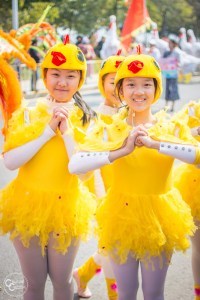 Celebrating Lantern Festival in Zhuhai.
Celebrating Lantern Festival in Zhuhai.While learning a whole new language might be a bit farfetched for just a simple vacation abroad, studying the culture is something that is not only super easy, but also extremely underrated. You can accomplish so much just by understanding how things work in a certain culture. Knowing the societal norms will enable you to know how to get things done and what to expect in certain situations.
Some things about Chinese culture are pretty widely known, and, dare I say, obvious, like, for example, the Chinese eat with chopsticks, but there is a lot that’s not talked about. Even knowing the little things like the fact that in most restaurants you seat yourself, for example, can save you a lot of frustration. It also allows the Chinese to be at ease when interacting with you, an incredible asset considering how timid a lot of people are here when it comes to communicating with foreigners.
How can you find out what to expect before coming to China?
It’s as easy as reading a couple articles online or a few chapters in a book. A great resource for us was the book Decoding China by Matthew B. Christensen which will tell you everything you need to know and more about how to get around in China.
Do some background research about the sites you’ll be visiting.
Most places don’t offer guided (or self-guided) tours in English, and the majority of the information signs will be solely in Chinese. If you’re not a history buff and are just going to said place to see the pretty scenery (cough, cough, guilty as charged) then this won’t be much of an issue for you. If you do want to know the history of the places you’re visiting though, it’s best to look that stuff up before you go.
Take a business card from your hotel.
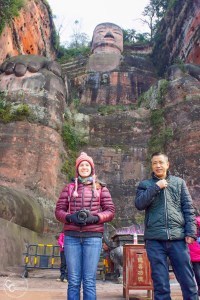 This Chinese guy thought he was so sly photobombing me in front of the Giant Buddha in Leshan.
This Chinese guy thought he was so sly photobombing me in front of the Giant Buddha in Leshan.Virtually every place of business in China has business cards available with the address, and, a lot of times, even a map of the business’s location. Most hotels have them sitting on the front desk. Remember to grab one to keep in your wallet. This way you’ll never have to be worried about finding your way back to a bed at the end of the day. Just show the card to a taxi driver, or person on the street if you’re lost, and they’ll point you in the right direction.
Download Pleco
Pleco is my best friend when out and about in China, and trust me, it will be yours too if you ever get into a communication bind. Pleco is a free offline English/Chinese dictionary app you can download to your phone. It provides more accurate translations than your typical translator and will speak the words aloud so you know how to say them.
The offline aspect of the app is especially handy for travelers, as unless you are connected to wifi or paying for international data, your phone won’t be able to connect to the internet to look up translations when you’re out and about.
Choose a restaurant with a picture menu.
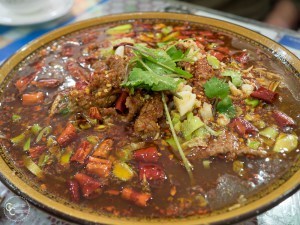 Typical Chinese cuisine from Sichuan Province. Every province in China has its own unique type of food.
Typical Chinese cuisine from Sichuan Province. Every province in China has its own unique type of food.This one is a lifesaver, especially if you’re not a particularly adventurous eater. I have to admit, even though I can read a lot of the Chinese on a menu, picture menus are still my jam when it comes to eating out. A lot of Chinese dishes don’t come with super intelligible names, even after you translate them. “Ants Climbing a Log” anyone? Don’t worry, there are no ants involved, it’s actually noodles. But how would you know without seeing the dish?
What do you do if you find yourself in the middle of nowhere and your only options are written Chinese menus with no pictures or translations?
Walk around with your waitress/waiter to other people’s tables and point at dishes that look good. Yes, I’m completely serious. Will you feel like a creeper, yes, will you eat a yummy meal, you sure will.
A rarer third option is that the waitress will invite you back into the kitchen so you can see all the meat and vegetables and pick out what you want. You’ll just be left guessing as to the preparation, but at least you’ll know it’s made with stuff you like. The one place this method is extremely common is at seafood restaurants, where everyone picks out their own live seafood, a treat if you’ve never had the experience of picking out the exact fish you want to eat for dinner!
Mime
When all else fails, channel your inner mime. You’d be surprised how much information you can communicate using just your body language. Hand signals and facial expressions can really go a long way. In fact, research shows that a surprising 55% of communication is done through body language. Take full advantage of your body language, and you’re already halfway there.
There are so many universal cues you can communicate using just your body. Rub your stomach or pretend to shovel food in your mouth if you’re hungry, lean your head against your hands if you are looking for someplace to sleep, you can even draw or show someone a picture of something you’re looking for. Get creative and you’ll be surprised how easily you can get by without words.
Ask your hotel’s receptionist for help.
 When I was in Chengdu, the receptionists at our hostel told us exactly which buses to take, and where the bus stops were so that my friend and I could go see the Pandas!
When I was in Chengdu, the receptionists at our hostel told us exactly which buses to take, and where the bus stops were so that my friend and I could go see the Pandas!Receptionists are often a wealth of information about the local area. It’s part of their job to provide guests with information on cool things to see and do and tell how to do them. Even now, I always ask the receptionist at my hotel in China a million and one questions before I head out exploring. They can always tell me how to get to a certain place or make suggestions about cool local places that I never even knew existed.
A lot of times they can even arrange transportation for you, whether it’s calling a cab and telling the driver where to take you, hiring a private car for the day, etc. A lot of times it’s hard to find information online about how to get to and from certain places you want to see in China, so if you can’t find all the information you need online, don’t sweat it. Your hotel receptionist will probably have better information anyway.
Bargain with a calculator.
If you’re shopping at a local market, most of the time you’ll have to bargain for prices. Seems like quite a daunting task for someone with no language skills, but with the use of a calculator, whether it’s in physical form or on your phone, you can throw numbers back and forth like a pro without having to say a word. You might not be able to verbally spar, but you can both understand written numbers. Pen and paper will also do just fine in a pinch.
Bonus Tips
There are some English terms that China has adopted into their language. 3 incredibly helpful terms to know are:
ATM – most Chinese will understand this, so if you’re in need of cash, just ask for an ATM.
WC – WC stands for Water Closet, aka toilet. So if you need to go to the bathroom, ask for a WC.
Wifi – How do you say wifi in Chinese? You guessed it, wifi.
Ready to tackle traveling in China?
This amazing country truly has so much to offer. From stunning natural landscapes and an incredible 3500 years of history to some of the most bustling modern cities in the world, China has something for everyone. Ignite your sense of adventure and your taste buds, use these tips, and get ready to explore, shop, and eat your way through this amazing place with ease.
Cara is an equestrian, photographer, writer, and lover of anything that includes the words “adventure” and “exploration”. Currently living as an expat in China with her husband, Justin, together they are on a mission to travel and see the world on a budget. Veering off into the unknown to really experience the local culture and natural scenery is what they yearn for. Cara shares all their experiences, lessons learned, and travel guides on Crawford Creations to help others replicate their unique form of travel.
The post How To Travel China Without Speaking Chinese – Guest Post by Cara Crawford appeared first on Two Americans in China...and growing!.
November 2, 2017
Fragrant Lamb and Bamboo Shoot Soup – Recipe By Tiana Matson
Fragrant Lamb and Bamboo Shoot Soup
Lamb is good for you and is perfect for warm winter casseroles and satisfying comfort food. Lamb can increase your body heat to resist the cold, so it is one of the best ingredients for winter meals.
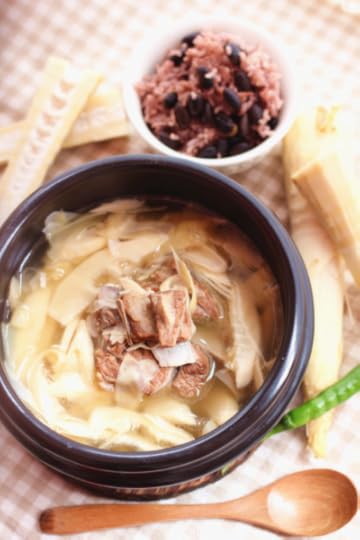
I remember during my childhood, my thrifty grandparents ate mostly vegetarian, but always cooked up a big batch of lamb soup every winter.
Lamb has a stronger smell than beef and poultry that is not liked by everyone, and some simply won’t eat it due to its unique ‘aroma.’ Lamb is so versatile, and often a cheaper alternative than beef, so it’s worth taking a good look at what you can do with it besides a leg roast and chops.
The method of cooking lamb is the same as for beef. You can braise it, stew it, make soup with it, even stir fry it. The difference is that to reduce lamb’s smell and increase its aroma, wine and spices are often used.
I often use lamb mostly for soup if I want a meat soup, however, it is also delicious braised and served with rice noodles. Today’s recipe is an Asian twist on lamb soup, and I’m sure you’ll love it!
The standard practice for lamb soups is to use herbs, but this time I’m using fresh bamboo shoots.
Sweet bamboo shoots are low in calories, low in fat, and rich in vitamins and fiber. Served with lamb (or steak) chops, the sweet bamboo shoots aid digestion.
This soup is different from the usual thick winter soup often made with lamb, but it highlights the lamb chops and sweet bamboo shoots, rather than just using the lamb as a stock base.
Ingredients:
300 g peeled sweet bamboo shoots
300 g lamb chops
150 ml cooking wine
800 ml boiling water
1 x 2” piece ginger
1 tablespoon tea oil
1 teaspoon salt
1 teaspoon pepper
Method:
Step 1
Wash the lamb chops and drain.
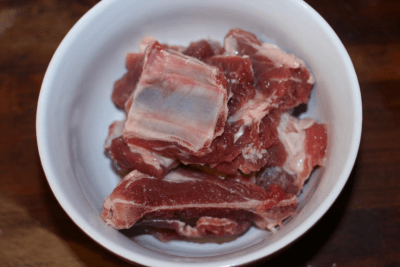
Step 2
Cut the sweet bamboo shoots in half lengthwise and wash. Slice the bamboo diagonally and put aside.
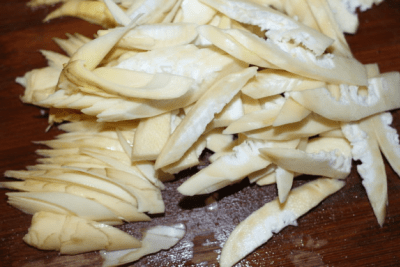
Step 3
Add the sweet bamboo shoots to a pot and fill with enough water to come to the top of them.
Step 4
Bring the bamboo shoots to the boil, and boil for 2-3 minutes.
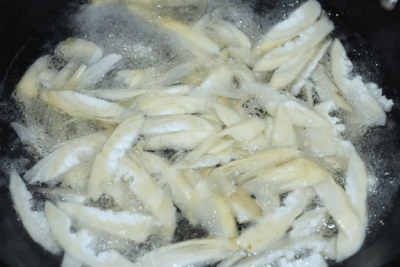
Step 5
Remove the bamboo shoots with a skimmer and put aside.
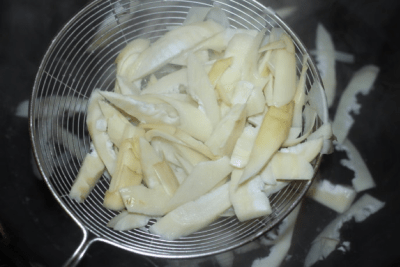
Step 6
Add the lamb shops to the water and boil for 20 seconds. Remove and put aside. Discard the water.
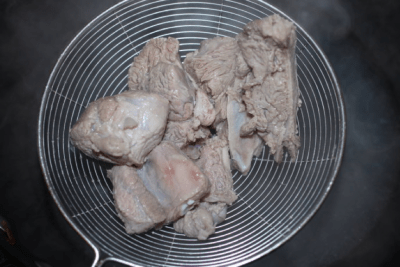
Step 7
Wash and slice the ginger.
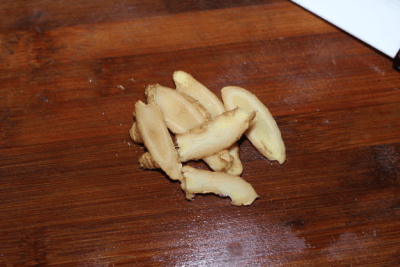
Step 9
Pour the tea oil in in the pan and spread it to cover the surface.
Step 10
Add the chopped ginger and sauté for a few seconds, and then add the lamb. Stir fry until golden brown.
Step 11
Pour in the cooking wine and simmer for 30 seconds.
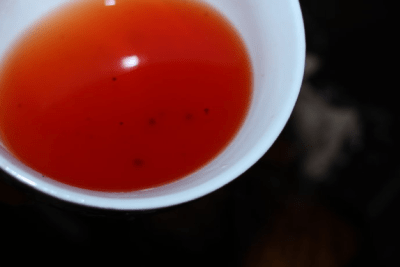
Step 12
Pour in the 800ml of boiling water.
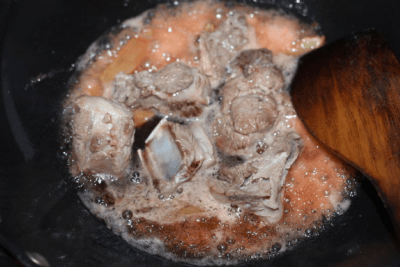
Step 13
Skim off the foam floating on the surface with a spoon.
Step 14
Transfer the meat and the liquid to a ceramic soup pot and simmer for 20 minutes.
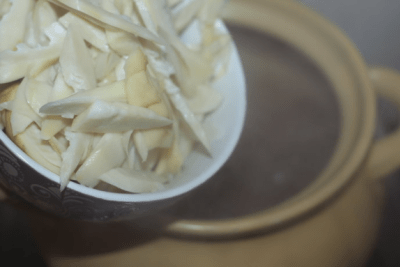
Step 15
Add the sweet bamboo shoots and continue to simmer the soup on low for one hour.
Step 16
Finally, season with salt and pepper, and serve.
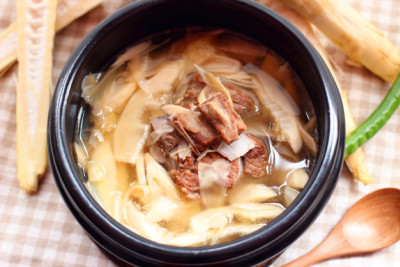
COOKNG TIPS:
Tea oil has the effect of ridding the ‘fishy’ smell from the meat, however, if you don’t have any tea oil at home, you can use other cooking oil instead.
The green wine can be replaced with cooking wine.
Boiling the sweet bamboo shoots helps to remove the oxalic acid.
SUMMARY
Warm and hearty, Sweet Bamboo Shoots and Lamb Soup is a perfect tummy filler for those chilly days. Fragrant and satisfying!
Tiana is a food blogger who loves to cook, she is the creator of https://www.yumofchina.com/, a site that shares authentic Chinese recipes and China culture.
The post Fragrant Lamb and Bamboo Shoot Soup – Recipe By Tiana Matson appeared first on Two Americans in China...and growing!.
October 30, 2017
The Racist Reason You Think MSG Is Bad For You
When you think of MSG, what are the first thoughts that come to mind? Probably that MSG is bad for you and that it is used in Chinese food. But have you ever wondered where this belief came from? Have you ever really researched MSG and its relation to Chinese food?
 A recent episode of Adam Ruins Everything (one of the best shows on TV) tackled this issue. Even though I live in China and have written about Chinese food quite a bit, I never gave MSG much thought. It can’t be avoided over here, so even though I believed it was an unhealthy food additive, I didn’t worry about it much. (Between the annual milk scandals and cancer-causing rice and water here in China, MSG has been a pretty low-order concern). But I remember when living in the US, everyone seems to know a Chinese restaurant that must be avoided because they used the dreaded MSG.
A recent episode of Adam Ruins Everything (one of the best shows on TV) tackled this issue. Even though I live in China and have written about Chinese food quite a bit, I never gave MSG much thought. It can’t be avoided over here, so even though I believed it was an unhealthy food additive, I didn’t worry about it much. (Between the annual milk scandals and cancer-causing rice and water here in China, MSG has been a pretty low-order concern). But I remember when living in the US, everyone seems to know a Chinese restaurant that must be avoided because they used the dreaded MSG.
However, the shocking truth is that this fear of MSG is far more rooted in racism than concern for public health. As Adam Conover explains in “Adam Ruins Spa Day“, MSG was discovered and created by Japanese chemist Kikunae Ikeda in 1907. The seasoning caught on, not just in East Asia, but around the world. By the 1950s, every restaurant and chef in the world was using it, and it was a staple in most American kitchens.
So even though MSG was used by almost everyone at the time, this doctor only pointed the finger at Chinese restaurants, inexorably linking MSG to Chinese restaurants and Chinese food ever since.
 And lest you doubt the racial component here, have you ever heard anyone complain about MSG in Doritos? Or Campbell’s Soup? No. The only times I have ever heard anyone complain about MSG is in relation to Chinese food.
And lest you doubt the racial component here, have you ever heard anyone complain about MSG in Doritos? Or Campbell’s Soup? No. The only times I have ever heard anyone complain about MSG is in relation to Chinese food.
But is there a reason to worry about MSG in your food? No. No study has ever found a link between MSG and supposed “side effects.” In fact, MSG is naturally occurring in your own body and you would die without it.
The history of MSG, the xenophobic reactions to it, and the extreme ways chefs are trying to recreate MSG without the negative stigma is all pretty fascinating and I encourage you read more about it and check out Adam Ruins Everything.

Check out The Crazy Dumplings Cookbook!
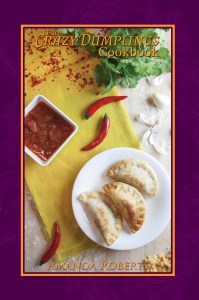
Dumplings. Wontons. Jiaozi. This remarkably simple food is found throughout Asia and in Chinese restaurants and kitchens around the world, but have you ever filled a dumpling wrapper with chicken? Lobster? North American Plains Bison? Hardly anyone has! The Crazy Dumplings Cookbook features over 100 recipes with some of the craziest and most delicious dumpling filling recipes you will ever see. From Chicken Taquito Dumplings to Timey-Wimey Dumplings to a dumpling for your dog, Crazy Dumplings will show you all the crazy things you can stuff into a dumpling wrapper for an easy meal or snack.
Amazon |B&N | iBooks |Kobo | Google
The post The Racist Reason You Think MSG Is Bad For You appeared first on Two Americans in China...and growing!.



